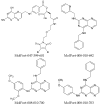Identification of Potential Pteridin Reductase-1 Inhibitors for the Treatment of Leishmaniasis: A Bioinformatics Approach
- PMID: 40872625
- PMCID: PMC12389166
- DOI: 10.3390/ph18081237
Identification of Potential Pteridin Reductase-1 Inhibitors for the Treatment of Leishmaniasis: A Bioinformatics Approach
Abstract
Background/Objectives: Leishmaniasis is an infectious disease caused by digenetic protozoa of the genus Leishmania, transmitted by infected female sandflies of the Phlebotominae subfamily. Current treatments are limited, relying on drugs that were not specifically developed for this disease and are often associated with high toxicity and elevated costs. Among alternative therapeutic strategies, antifolate compounds have been investigated due to their ability to inhibit dihydrofolate reductase (DHFR), an enzyme essential for folate metabolism in the parasite. However, the parasite circumvents DHFR inhibition through the activity of pteridine reductase-1 (PTR-1), which maintains folate reduction and ensures parasite survival. In this context, this study aimed to identify potential PTR-1 inhibitors in Leishmania major through in silico approaches. Methods: The methodology included virtual screening of molecular databases, Tanimoto similarity analysis, pharmacokinetic and toxicological predictions, and biological activity evaluation in silico. The most promising compounds were further analyzed via molecular docking. Results: The virtual screening resulted in 474 molecules, of which 4 structures (M601, M692, M700, and M703) showed high potential as PTR-1 inhibitors in Leishmania major throughout all stages of the methodology employed, especially in the results of molecular docking where they exhibited strong binding affinities and significant interactions with key residues of the target enzymes. Conclusions: This work provides a solid foundation for advancing these molecules into experimental validation, contributing to the development of safer and more effective therapeutic alternatives for the treatment of leishmaniasis.
Keywords: Leishmania major; methotrexate; molecular docking; pteridine reductase-1; virtual screening.
Conflict of interest statement
The authors declare no conflicts of interest.
Figures










References
-
- Ministério da Saúde . Manual de Vigilância da Leishmaniose Tegumentar. Ministério da Saúde; Brasília, Brazil: 2017.
-
- Rodrigues M.G.A., Sousa J.D.B., Dias Á.L.B., Monteiro W.M., Sampaio V.S. The role of deforestation on American cutaneous leishmaniasis incidence: Spatial-temporal distribution, environmental and socioeconomic factors associated in the Brazilian Amazon. Trop. Med. Int. Health. 2019;24:348–355. doi: 10.1111/tmi.13196. - DOI - PubMed
-
- Gosch C.S., Marques C.P., Resende B.S., Souza J.D.S., Rocha R.A.S., Lopes D.S.S., Gosch M.S., Dias F.R., Dorta M.L. American tegumentary leishmaniasis: Epidemiological and molecular characterization of prevalent leishmania species in the state of Tocantins, Brazil. Rev. Inst. Med. Trop. 2017;59:2011–2015. doi: 10.1590/s1678-9946201759091. - DOI - PMC - PubMed
LinkOut - more resources
Full Text Sources

